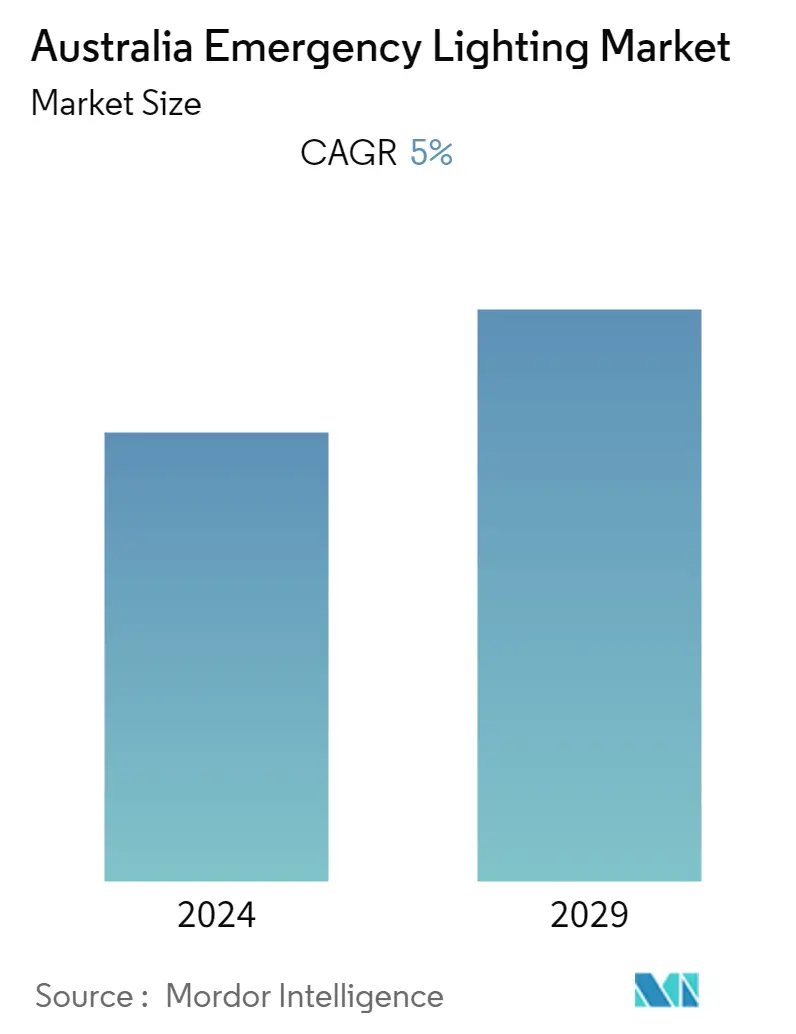Market Size of Australia Emergency Lighting Industry

| Study Period | 2019 - 2029 |
| Base Year For Estimation | 2023 |
| Forecast Data Period | 2024 - 2029 |
| Historical Data Period | 2019 - 2022 |
| CAGR | 5.00 % |
| Market Concentration | High |
Major Players
*Disclaimer: Major Players sorted in no particular order |
Australia Emergency Lighting Market Analysis
The Australian emergency lighting market is expected to register a CAGR of 5% during the forecast period.
- The increasing demand for energy-efficient lighting systems across the commercial, residential, and industrial sectors is driving the growth of low-power consumption bulbs in the emergency lighting system.
- Technological advancement in the lighting market has led to the development of energy-efficient, self-diagnostic with an extended lifespan, driving the market's growth. Moreover, the government's strict fire and safety regulations are expected to flourish in the Australian emergency lighting market. Further, in September 2022, according to Australasian Fire and Emergency Service Authorities Council (AFAC), a new nationally consistent bushfire danger rating system started across Australia, providing more explicit and accurate information to communities at risk of bushfires.
- The need for more commercial buildings, social spaces, housing, and infrastructure comes with a growing population. Sector-wise, the value of construction work in the private sector was significantly higher than in the public sector. According to the Australian Bureau of Statistics (ABS), in 2022, the total number of dwellings under construction arrived at 241,926 in June, an additional 0.7% increase from the record raised in March of 240,156 homes. This increase was driven by new private sector houses, which have increased to record highs since March 2021, with 102,908 new private dwellings under construction in June 2022.
- Furthermore, the Australian market is also witnessing several strategic collaborations with a global player to gain significant market share in the regional market. For instance, Clevertronics, an Australian evacuation product company, recently partnered with Wirepas, Finland's wireless IoT connectivity provider. The partnership is expected to enable Clevertronics to provide the market with massive-scale, low-cost smart emergency lighting solutions. The easily installable solutions are quickly proving a success, with already 630 sites across Australia, New Zealand, and the United Kingdom deployed in just a few years.
- Moreover, the supporting government regulations (National Construction Code) provide the minimum requirements for the safety and health of workers that are necessary to incorporate in all the on-site construction, such as adequate emergency lighting to guide the constructor to safely exit the place in case of any failure of standard artificial lighting during an emergency. Further, in May 2022, the Australian Building Codes Board released Stage 1 of the NCC 2022 as a general preview in preparation for its execution in September 2022.
- The Internet of Things (IoT) advancement has led to the emergence of networked and communications-enabled emergency lights systems (IoT based). Most key vendors are developing and commercializing IoT-based emergency light systems that can be operated through smartphones. For instance, WBS Technology's EMIoT is an emergency lighting network and testing system that leverages IoT technology to create a cost-effective, wireless cloud solution that allows live remote monitoring of 99% of the building with no cabling or additional hardware. Its implementation in smart buildings is expected to drive the market in the future.
- According to global Australia, the Internet of Things, smart devices connected to the internet that collect and share data, can boost Australia's GDP by USD 230 billion over the next decade. Further, the number of companies operating in blockchain and cryptocurrency exploded by 153%. Australian industry players are expected to contribute an estimated global annual business value of more than USD 175 billion by 2025.
- However, significant barriers to market revenue growth include high initial investments, an extensive cabling system requirement, and a need for appropriate system integrity. The high cost of emergency power and lighting systems, equipment, installation, and wiring will significantly reduce customer desire.
- Amid the outbreak of COVID-19, the market witnessed a production shutdown and disruption in the supply chain, leading to weakened industrial output growth and a decline in light-manufacturing production across significant manufacturing hubs. Major halts in construction activities during the initial phase of the pandemic have resulted in a slump in demand for lighting products, as the construction industry used to be a significant adopter of emergency lighting systems. Furthermore, the construction industry is anticipated to register substantial growth in the forecast period.
Australia Emergency Lighting Industry Segmentation
Emergency lighting ensures that the lighting is provided consistently and automatically for a sufficient time during a power outage or specific emergencies that enable the people trapped in such blackout situations to evacuate safely.
The studied market is segmented by power systems such as self-contained power systems and central power systems among residential, industrial, and commercial (offices, malls, etc.) end-user verticals. The impact of Covid-19 on the market and impacted segments are also covered under the scope of the study. Further, the disruption of the factors affecting the market's expansion in the near future has been covered in the study regarding drivers and restraints.
The market sizes and forecasts are provided in terms of value (USD million) for all the above segments.
| By Power System | |
| Self-contained Power System | |
| Central Power System |
| By End-user Vertical | |
| Residential | |
| Industrial | |
| Commercial |
Australia Emergency Lighting Market Size Summary
The Australian emergency lighting market is experiencing growth driven by the increasing demand for energy-efficient lighting systems across various sectors, including commercial, residential, and industrial. Technological advancements have led to the development of energy-efficient and self-diagnostic lighting solutions with extended lifespans, which are further propelled by stringent government fire and safety regulations. The market is also benefiting from the rapid urbanization and the consequent rise in construction activities, particularly in the private sector, which has seen a significant increase in the number of dwellings under construction. Strategic collaborations, such as the partnership between Clevertronics and Wirepas, are enabling the provision of smart emergency lighting solutions, enhancing market penetration. Additionally, the integration of IoT technology in emergency lighting systems is expected to drive future market growth, offering cost-effective and wireless solutions for live remote monitoring.
The market is characterized by the increasing adoption of LED lighting due to its energy-efficient and cost-saving benefits, supported by government policies banning incandescent lights. The penetration of LEDs is further encouraged by their controllability and longer lifespan compared to traditional bulbs. The Australian emergency lighting market is concentrated with a few dominant players, such as WBS Technology ABN, ABB Australia, and Clevertronics Pty Ltd, who are expanding their global presence through strategic collaborations and acquisitions. Despite challenges like high initial investments and the need for extensive cabling systems, the market is poised for growth, driven by the ongoing demand for emergency lighting solutions in response to power outages and the need for compliance with national safety standards.
Australia Emergency Lighting Market Size - Table of Contents
-
1. MARKET INSIGHTS
-
1.1 Market Overview
-
1.2 Industry Value Chain Analysis
-
1.3 Industry Attractiveness - Porter's Five Forces Analysis
-
1.3.1 Threat of New Entrants
-
1.3.2 Bargaining Power of Buyers
-
1.3.3 Bargaining Power of Suppliers
-
1.3.4 Threat of Substitute Products
-
1.3.5 Intensity of Competitive Rivalry
-
-
1.4 Emergency Lighting Implementation Standards in Australia
-
1.5 Impact of COVID-19 on the Market
-
-
2. MARKET SEGMENTATION
-
2.1 By Power System
-
2.1.1 Self-contained Power System
-
2.1.2 Central Power System
-
-
2.2 By End-user Vertical
-
2.2.1 Residential
-
2.2.2 Industrial
-
2.2.3 Commercial
-
-
Australia Emergency Lighting Market Size FAQs
What is the current Australia Emergency Lighting Market size?
The Australia Emergency Lighting Market is projected to register a CAGR of 5% during the forecast period (2024-2029)
Who are the key players in Australia Emergency Lighting Market?
ABB Australia(ABB Ltd), WBS Technology ABN , Clevertronics Pty Ltd, Haneco Lighting Australia Pty Ltd. and E&E Lighting Australia are the major companies operating in the Australia Emergency Lighting Market.

